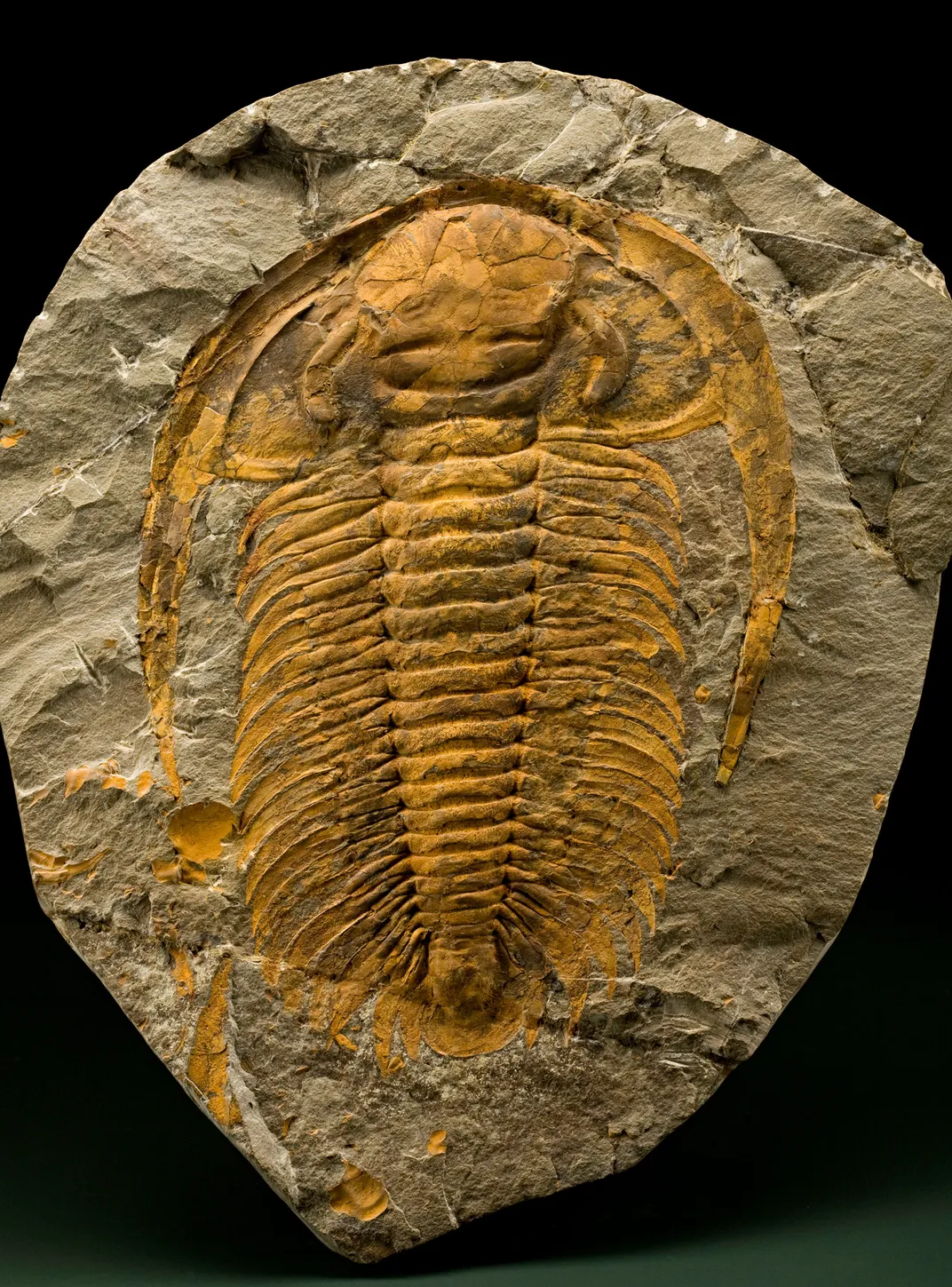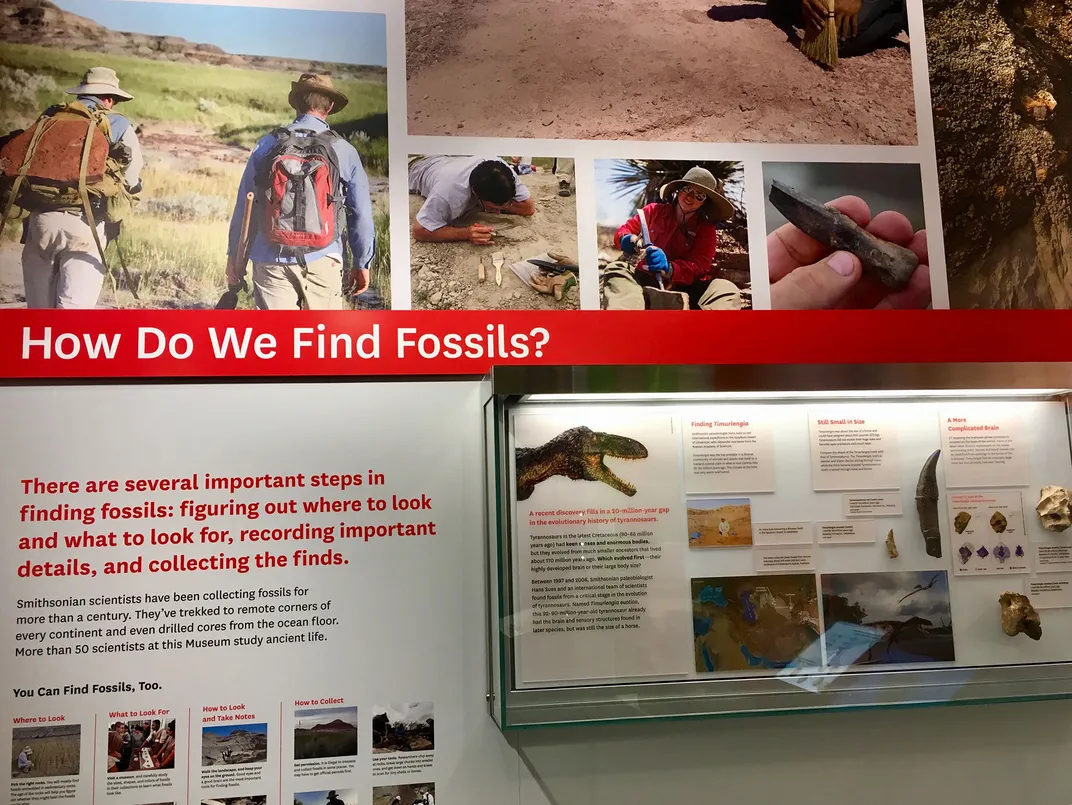How Do Paleontologists Find Fossils?
Smithsonian’s Hans-Dieter Sues, who has collected fossil vertebrates in the U.S. and around the world shares some of his tips
/https://tf-cmsv2-smithsonianmag-media.s3.amazonaws.com/filer/2d/4a/2d4a1922-295a-4f87-8440-c19aa8f9fbfa/h-ds_uzbek__dino_braincase.jpg)
This is the first in a five-part series written by experts featured in the Smithsonian's new Hall of Fossils—Deep Time exhibition opening June 8 at the National Museum of Natural History. The full series can be found by visiting our Deep Time Special Report
In Thomas Hardy’s 1873 novel A Pair of Blue Eyes, Henry Knight tries to impress the heroine, Elfride Swancourt, by showing her how air currents rise up a steep sea cliff. A sudden gust carries off his hat and, attempting to catch it, he slips down the incline. Knight ends up clinging to the cliff for dear life. Being of a scientific bent, he studies the cliff face even in this dire situation.
“By one of those familiar conjunctions of things wherewith the inanimate world baits the mind of man when he pauses in suspense, opposite Knight’s eyes was an imbedded fossil, standing forth in low relief from the rock. It was a creature with eyes. The eyes, dead and turned to stone, were even now regarding him. It was one of the early crustaceans called Trilobites.”
With more than 15,000 recorded species, trilobites were a fantastically diverse group of arthropods that roamed the oceans from about 540 million to 252 million years ago. Considered relatives of crustaceans in Hardy’s day, they are now interpreted as an entirely extinct evolutionary radiation of early arthropods. Arthropods are characterized by pairs of jointed legs and a segmented exoskeleton. Today, they account for more than 80 percent of animal species and include insects, spiders, crabs and their many relatives.

About a century after Hardy penned his novel, I sat at an exposure of shale along the edge of a dark wood in Germany. I was a high school student traveling with fellow collectors and looking for fossils from the Devonian Period, 358 million years to 419 million years ago. I kept splitting blocks of shale to look for fossils buried within them. With a slight tap of my rock hammer, a piece of rock parted to reveal the head shield of a trilobite. The fossil stared back at me with its sightless eyes while I marveled at the fact that I was the very first human to see it after it had spent some 390 million years in the ground.
The imperiled Mr. Knight accidentally came face to face with a trilobite. By contrast, I did so after studying geological maps. I knew the age of the shale and I had a pretty good idea of the kinds of extinct animals I might find. The two stories nicely illustrate the two most common ways of finding fossils.

Collecting does not require formal training. Indeed, some of the finest collectors I have hunted fossils with include a policeman and a veterinarian. Many people collect fossils because they are tangible mementos of Earth’s unimaginably long history. The fantastic shapes of certain fossils make them objects of aesthetic pleasure to other collectors.
Many fossils are discovered by sheer accident. In 1906, a German prospector in present-day Tanzania came across a huge bone weathering out of the ground in a forest. This find led to the discovery of one of the largest dinosaur graveyards in the world. In 2002, an Italian marble cutter discovered the skeleton of an early whale inside a large block of 40-million-year-old marblized limestone from Egypt while slicing the rock into slabs for architectural use. Just recently, scientists recognized a piece of a mandible found by a monk in a cave in Tibet as the first good record of an as-yet-mysterious species of ancient humans. The monk had entered the cave to find a quiet place to pray when he noticed the bone on the cave floor.
Although there is always a major element of luck in finding fossils, professional paleontologists and experienced avocational collectors do not leave things to chance. The careful study of geological maps helps to identify suitable areas for prospecting. Fossils occur in sedimentary rocks, which were deposited by wind or water. By contrast, igneous rocks, which formed from hot molten material that would burn any biological life, do not contain fossils. My own research focuses on vertebrate fossils from the Triassic Period, 252 million years to 200 million years ago. Worldwide, there are only a few dozen places with rocks that could potentially contain such remains. Here in the populated eastern seaboard of the United States, most of the rock formations from the Triassic are covered by buildings, parking lots or dense vegetation.
Sites for prospecting are largely restricted to roadcuts, construction sites and quarries. An important site in central Virginia that I excavated many years ago is now buried beneath a school football field. By contrast, the colorful arid lands of the American Southwest are the stuff of paleontologists’ dreams. There, you can collect lots of fossils without having to worry about being obliterated by vehicles passing inches away.
Looking for fossils takes patience and perseverance. Sometimes you spend days or weeks in the field before finally making an interesting find. Some rock layers just don’t have that many fossils. I have collected fossils of Triassic vertebrates along the shores of the Bay of Fundy in eastern Canada, where on average, I find only three or four pieces of bone per mile of shoreline. Most of these are so incomplete it is impossible to tell what bone they are, much less which animal they came from. Even so, over the many years searching the area, other collectors and I have assembled a sizeable collection of fossils—many of them species new to science.
Some collectors have a real knack for finding fossils even where they are rare. Others bring great enthusiasm but will literally step on fossils without seeing or recognizing them. Success heavily depends on quickly learning how to distinguish fossils in a particular type of rock. When I first started collecting along the shores of the Bay of Fundy it took some time before I was able to tell cross-sections of white bones on surfaces of red sandstone from similar-looking mineral inclusions and bird droppings.
My tool kit for fossil hunting contains rock hammers, chisels, protective glasses, a loupe, my notebook, various kinds of glue, and packing material and crates. Before visiting a place with exposures of rocks that I want to study, I am careful to obtain permission from the land owner. Unless collecting is done merely for mementos, it is extremely important to record details about the fossil sites and their exact location. When first uncovered, fossils are often fragile and must be stabilized with glue. Then each find is carefully wrapped and labeled before being taken to a lab or to the museum. One material that is most popular and works splendidly for wrapping small fossils is toilet paper. Large specimens often require protective jackets made of plaster bandages similar to those used by medical doctors to stabilize broken bones.
In over 40 years I have worked the rocks, searching them for finds that might bring still more knowledge of what roamed this planet millions and millions of years ago, I have probably pulled thousands of fossils from the ground. I’ve never lost the wonder. To be the first human to find and touch an extinct creature is a singular moment that cannot be easily put into words. “These old stones, give them a voice and what a tale they’d tell,” wrote Aeschylus in the ancient Greek play Agamemnon.
I shall never tire of listening to those tales.
/https://tf-cmsv2-smithsonianmag-media.s3.amazonaws.com/accounts/headshot/HansDS2018.jpg)


/https://tf-cmsv2-smithsonianmag-media.s3.amazonaws.com/accounts/headshot/HansDS2018.jpg)